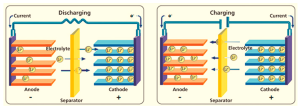Frequently asked questions about solar batteries
What Distinguishes a Lithium-ion Battery from A Lithium Battery?
Because of the way their main cells are constructed, lithium batteries are meant to be used only once. In contrast, the secondary cell architecture of lithium-ion batteries allows them to be recharged numerous times.
What Drawbacks Do Lithium-ion Batteries Have?
Higher temperatures pose a risk of overheating and decreased safety for lithium-ion batteries.
What Identify Lead Acid Battery from Lithium-ion Battery?
The materials that are used to make lead acid and lithium-ion batteries differ from one another. Lithium-ion batteries have a greater capacity and are more efficient than lead acid batteries, although being more expensive.
Are Solar Batteries Worth it?
A solar system that includes a battery has a longer payback period than one that only consists of solar panels. Batteries can prevent power bill shock, lower or eliminate electricity bills, and pay for themselves. Customers of solar batteries can also benefit from other features that cannot be measured in monetary terms, such as:
Achieving energy self-sufficiency
Defence against power outages
A reduced carbon footprint
Visit our page Why Install a Solar Battery for a more thorough examination of the benefits of solar power.
Do Solar Batteries Offer Blackout Protection?
An option to defend against power outages is available for the majority of solar battery storage systems. This feature could need particular solar battery system configurations and settings, and it is not always accessible with all batteries. If you think your solar battery needs blackout protection, please talk to your Maxworldpower specialist.
May I Keep an Eye on the Solar Battery?
Every battery that Maxworldpower installs has smartphone apps and battery management software that can monitor solar energy systems and assist in controlling battery power use. Owners of solar batteries modify their behaviour and consumption to become more energy independent as they become more conscious of their power usage patterns.
Which Factor Has the Biggest Influence on Battery Life?
The degree of warmth. Because of this, storing your batteries properly in a somewhat cold place will have the biggest impact on how long they live. A solar battery backup’s longevity is directly impacted by its battery’s temperature, thus it’s critical to maintain the inclosure properly and provide adequate cooling and freezing protection.
For asolar battery, higher voltage is needed to obtain maximum charge if its temperature falls below 30 degrees Fahrenheit; if it climbs above the 90-degree Fahrenheit threshold, overheating will occur and further charge will be needed. Temperature moderation is a function that many top battery manufacturers, including Tesla, LG, and Q Cells, offer to aid with this issue. The life of your batteries can be greatly increased by selecting a reputable battery manufacturer and making routine maintenance checks to guarantee appropriate temperature management.
How Long Can My House Run on A Solar Battery?

What loads your solar battery can sustain, how much energy your home uses on a daily basis, its capacity and power rating, and whether or not you are linked to the grid are just a few of the factors that have an impact. You should have enough battery power to keep your house running for several days, even in the event that your solar panels aren’t generating any energy. Certain batteries can receive a power outage-related recharge from your solar panels.
Maxworldpower Pro Tip: In a perfect world, your solar panels would be able to replenish your backup batteries during a blackout. However, not every solar battery can do this.
A typical solar battery has a capacity of 10 kWh, and the US electricity Information Administration (EIA) estimates that the average US family uses about 30 kWh of electricity per day. Consequently, you would want a minimum of three (3) solar batteries to assist offset your daily use if you wanted to run your entire home on solar power.
However, in real life, the application is a little more complex because you will also need to use your battery to generate power for roughly 6-7 hours during the day during the hours of maximum sunshine. If you drive an electric vehicle (EV), such as a Tesla Model 3, you are likely familiar with how your car’s battery can automatically charge to 90%. Your solar battery shouldn’t be fully charged until it is absolutely necessary. This shortens the lifespan of your battery over time.
Ultimately, if you are using a solar PV array in conjunction with your battery, one or two batteries should be able to supply enough power when your panels aren’t working during the nighttime. Nonetheless, in the absence of a sustainable energy option such as solar panels, you might require three or more batteries to run your whole house for a whole day. In addition, you should build backup power for one or two more days to account for days when you might experience overcast weather if you are installing home energy storage with the intention of going off-grid and disconnecting from the electric grid.






